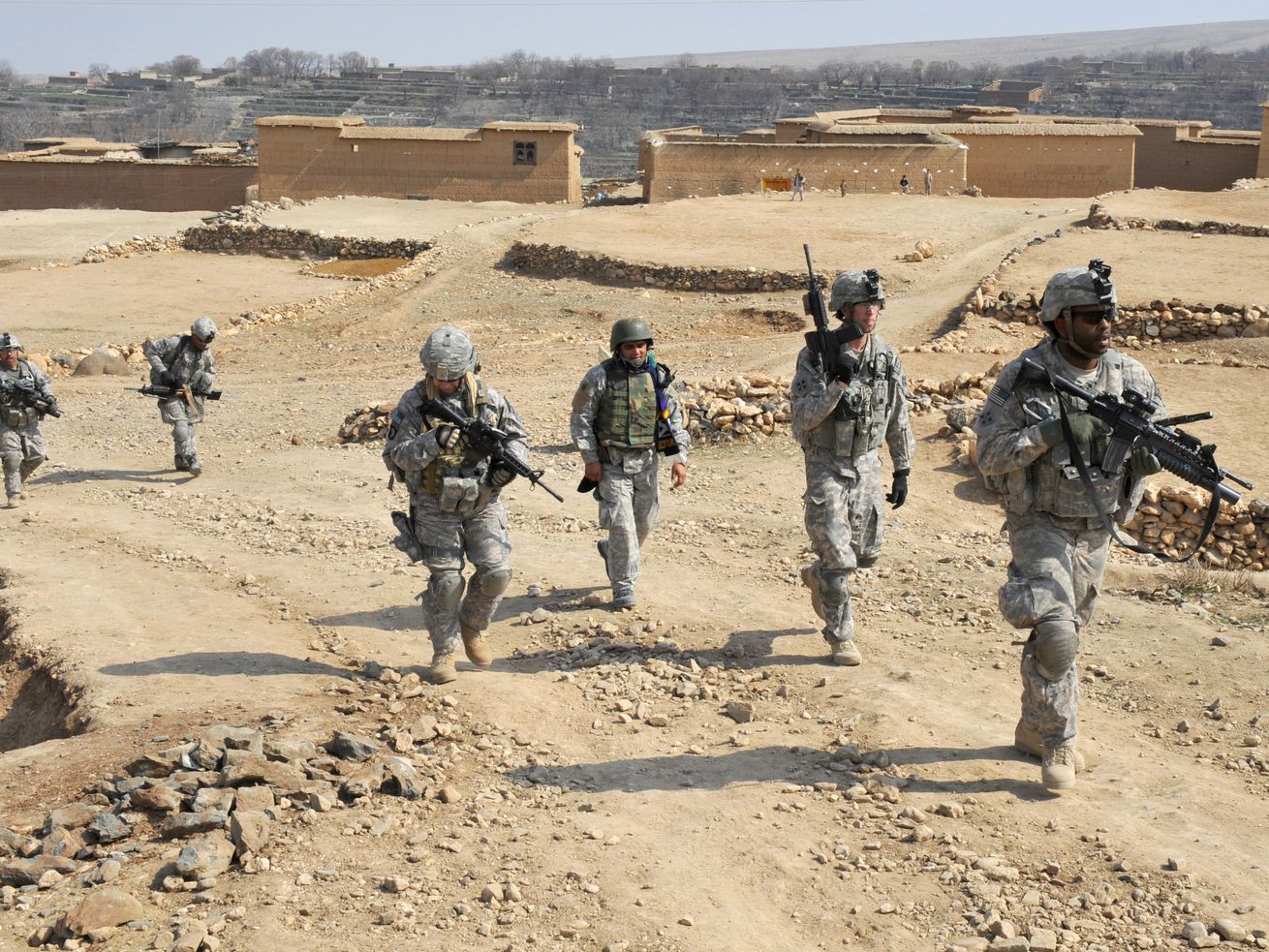As the US withdrawal deadline nears, “Operation Allies Refuge” will evacuate Afghans who helped American forces.
The Biden administration will begin evacuating thousands of Afghans who worked for the US government later this month, ahead of an August 31 deadline for the end of US military operations in Afghanistan.
Current and former Afghan translators, interpreters, and others who have worked with the US government in Afghanistan are facing deadly danger as the US drawdown continues and the Taliban reclaims territory once controlled by Afghan and coalition forces.
As Task & Purpose reported this month, “an estimated 70,000 Afghans who have worked for the United States — and their family members — are at risk of being killed as the Taliban push for a final victory.”
Because of that danger, according to a senior administration official, flights for “interested and eligible Afghan nationals and their families who have supported the United States and our partners in Afghanistan and are in the [Special Immigrant Visa] application pipeline” will begin in the last week of July as part of Operation Allies Refuge.
The Special Immigrant Visa, or SIV, program allows Afghans who work or worked “by or on behalf of the U.S. government in Afghanistan,” as well as family members, to qualify for visas and lawful permanent resident status in the US.
JUST IN: The White House is launching “Operation Allies Refuge” to evacuate Afghan nationals who assisted US and allied forces (plus families) from Afghanistan.
From a senior administration official: pic.twitter.com/4Bet68C6hb
— Andrew Feinberg (@AndrewFeinberg) July 14, 2021
“Our message to those women and men is clear,” President Joe Biden said in a speech about Afghanistan earlier this month. “There is a home for you in the United States if you so choose, and we will stand with you just as you stood with us.”
On Thursday, White House press secretary Jen Psaki told reporters that some 20,000 Afghans have applied for SIVs so far, though the number eligible is likely far larger — potentially as many as 100,000 people, according to Deutsche Welle.
Psaki says approximately 20,000 Afghans have applied for the special immigrant visas for Afghans that supported the U.S. during the Afghanistan War and details how the vetting process for the visas will work. pic.twitter.com/PDhEx6QZnk
— CBS News (@CBSNews) July 15, 2021
The news comes after sustained bipartisan scrutiny from lawmakers, including Sen. Angus King (I-ME), who said last month that he “[wanted] the White House’s hair on fire” over the issue — and a rapid Taliban offensive in Afghanistan has only heightened concerns.
“It’s not only a moral issue, it’s a national security issue,” King told reporters in a telephone briefing, according to Military.com. “This can’t just be business as usual at the State Department. … History judges you for how you go into a war, but also how you leave it.”
Currently, however, only about 2,500 of those evacuees in the SIV program will be allowed to travel directly to the US, according to NBC News. Many others — about 10,000 people whose background checks for a visa are still pending — will instead likely be flown to third countries or to overseas US military bases. Details are still unclear, but Guam, a US territory, is reportedly under consideration as an interim location.
Congress wants to do more for the US’s Afghan allies
Congress has welcomed the Biden administration’s announcement — but lawmakers are still urging the White House to do more to protect the US’s Afghan allies and ease their entry into the US, as well as pushing for legislative solutions.
One such bill, the proposed HOPE for Afghan SIVs Act, would postpone the SIV medical exam requirement until applicants arrive in the US, eliminating a major hurdle for many Afghans.
As things stand, limited access to clinics in Afghanistan that can conduct the exam has created a chokepoint in the process. According to Rep. Jason Crow (D-CO), one of the bill’s cosponsors and a former US Army Ranger who served tours in Iraq and Afghanistan, “there is currently only one facility in Kabul that conducts all immigrant visa examinations for the entire country, forcing applicants from the outer provinces to travel to Kabul in often dangerous circumstances.”
/cdn.vox-cdn.com/uploads/chorus_asset/file/22724704/1199133165.jpg) Andrew Quilty/The Washington Post/Getty Images
Andrew Quilty/The Washington Post/Getty ImagesThe measure passed the House late last month by a bipartisan vote of 366 to 46 and has bipartisan backing in the Senate.
“Approximately 20,000 Afghans are currently stuck in the backlog,” Sen. Alex Padilla (D-CA) said in a statement with Sen. John Cornyn (R-TX). “This bill is a commonsense solution that will help pave a more expeditious path to safety for these Afghans and their families.”
In many cases, the Taliban marks interpreters for death specifically for their cooperation with the US. Some have already been killed, or their family members have been targeted — according to the advocacy group No One Left Behind, more than 300 interpreters and their family members have been killed since 2014.
“I gave everything I had to the Americans, but once they are gone, I will be killed,” one former Afghan interpreter for US forces, Abdul Rashid Shirzad, told the Washington Post. “They keep track of us, and they don’t shoot us like they do Afghan soldiers. If they catch me, they will behead me.”
Currently, Shirzad’s SIV application is pending, according to the Post. In 2016, he was denied a visa for reasons that remain unclear.
‘Why didn’t we do this before we withdrew our forces?” Matt Zeller, co-founder of No One Left Behind, shares a harrowing story to illustrate the frantic desperation of Afghan interpreters who worked with the U.S. trying to escape the Taliban’s advance. @mattczeller @n1leftbehind pic.twitter.com/0fSWouSEGA
— Maddow Blog (@MaddowBlog) July 15, 2021
Separate from the the HOPE for Afghan SIVs Act, Sen. Pat Leahy (D-VT) is also pushing for Congress to raise the cap on SIVs to 46,500 visas — a potential increase of 20,000 from current levels.
There are currently several permutations of the SIV program, according to the State Department. Special immigrant visas are also available to Iraqis who worked with the US, and specifically for Iraqi and Afghan translators and interpreters who worked with the US military.
Leahy’s proposed cap increase is part of a potential $3.7 billion security supplemental, which Leahy introduced last week to increase funding for Capitol security in the wake of the January 6 attack.
The package would also make a number of other changes to the SIV program. According to Roll Call’s Caroline Simon, the Leahy plan would “reduce the employment requirement for eligibility from two years to one year, postpone the required medical exam until the applicant reaches the United States, overhaul the appeal process for denials and provide SIV status for family members of murdered applicants, among other changes.”
And it would include $100 million in “emergency aid” for an expected surge in Afghan refugees as the Taliban continue to claw back territory in Afghanistan.
Many of those same provisions are also included in the standalone Afghan Allies Protection Act, a bipartisan bill cosponsored by King, Leahy, and 15 other senators. A version of the bill also has bipartisan support in the House.
However, the Leahy plan for the Afghan SIV program doesn’t have universal support: Sen. Richard Shelby (R-AL), the ranking member opposite Leahy on the Senate Appropriations Committee, has instead proposed a much narrower supplemental package that would only fund Capitol security and does not include money for the Afghan SIV program.
“We made a promise to the Afghans who risked their own lives to support and protect our troops and our country,” Leahy said in a statement on the security supplemental. “As a country, our word is our bond, and we all agree, Republicans and Democrats, that bond will not be broken on our watch. If we do not address this now, then when?”
The US deadline to get out of Afghanistan is approaching quickly
As Leahy’s statement suggests, time is running out for Afghans who have worked with the US — and for the US to find a solution for its allies that meets the moment. In the same July speech where Biden announced the US evacuation effort for Afghan visa recipients, he also set a new withdrawal date for US forces: August 31.
That’s about a week and a half earlier than the previously announced date, September 11, and already, most US troops — more than 90 percent of all forces, according to US Central Command — have withdrawn from the country.
Earlier this month, the US pulled out of Bagram Air Base, the largest US airfield in the country. According to the AP, US soldiers made a quiet overnight departure, shutting off power to the base and leaving without alerting the incoming Afghan base commander.
Bagram has long been the hub for US operations in Afghanistan, and it carries additional symbolic importance as “a gateway to and from a war that cut across constant changes on the battlefield and in presidential administrations,” writes New York Times reporter Thomas Gibbons-Neff.
Last week, Army Gen. Austin “Scott” Miller officially stepped down from his post as the top US commander in the country, marking the effective conclusion of the US presence in Afghanistan. Only about 600 US troops are still in the country, according to the Washington Post — primarily to protect the US Embassy and international airport in Kabul, Afghanistan.
“Our job now is just not to forget,” Miller said ahead of his departure from Kabul Monday. “With the families that have lost people across this conflict, it will be important to know that someone remembers, that someone cares, and that we’re able to talk about it in the future.”
/cdn.vox-cdn.com/uploads/chorus_asset/file/22724758/1233976038.jpg) Alex Brandon/AFP/Getty Images
Alex Brandon/AFP/Getty ImagesPreviously, the Trump administration had set May 1 of this year as the deadline to end the US troop presence in Afghanistan; under Biden, May 1 became the start date for a final US withdrawal.
The withdrawal has generated substantial pushback: Former President George W. Bush criticized it as a “mistake” last week in an interview with Deutsche Welle, and former top US Afghanistan commander Gen. David Petraeus told CNN Sunday that “I fear we will look back and regret the decision to withdraw.”
“I’m afraid Afghan women and girls are going to suffer unspeakable harm,” Bush, who launched the US war in Afghanistan in 2001, said. “They’re just going to be left behind to be slaughtered by these very brutal people, and it breaks my heart.”
Biden has said the US will continue to support the Afghanistan government and provide humanitarian assistance, but he stood by his decision to withdraw US troops in remarks this month.
“Nearly 20 years of experience has shown us that the current security situation only confirms that ‘just one more year’ of fighting in Afghanistan is not a solution but a recipe for being there indefinitely,” he said.
The Taliban offensive doesn’t bode well for Afghanistan’s government
As the US drawdown continues, a major Taliban offensive against the Afghan army has succeeded in reclaiming large swaths of territory, raising fears that Kabul, Afghanistan’s capital, could fall in short order after the US mission there concludes.
Since the US withdrawal began in May, the Taliban have steadily expanded their reach in Afghanistan, and are now believed to control “more than a third of Afghanistan’s 421 districts and district centers,” according to the AP.
The Taliban’s increasing hold over Afghanistan.#AFPgraphics map showing parts of Afghanistan under government control and territories under the influence of the Taliban, from April to July 13 pic.twitter.com/f1Mbeuqvla
— AFP News Agency (@AFP) July 16, 2021
Casualties are also mounting: The Taliban murdered at least 22 Afghan commandos last month as they tried to surrender, and Reuters photojournalist Danish Siddiqui was shot and killed in Kandahar on Friday.
Some Afghan troops have also fled the country in the face of the Taliban offensive, crossing the border into neighboring Tajikistan in the north.
Those stories reflect what the Washington Post reported last month is “the new consensus” of US intelligence officials: That the Kabul-based Afghan government, led by President Ashraf Ghani, could fall to the Taliban over the next six months to a year.
The rapid Taliban advance reportedly led the US to consider delaying its withdrawal from Bagram, but officials ultimately opted against it.
Even if the Afghan government remains intact, however, the Taliban offensive is a bad sign. In June, Miller, the former US commander in Afghanistan, warned that Afghanistan could slide into a civil war as the US presence there dwindles.
Whatever happens afterward, however, the US timetable is clear: After two decades of war, US military operations will wind down on August 31.
And with most troops already out of the country, there’s more urgency than ever in the fight to save America’s Afghan allies.
“This is a massive step in the right direction,” Rep. Seth Moulton (D-MA), a Marine Corps veteran, said of the newly announced Operation Allies Refuge. “Now, we just need to keep pressure on the White House to ensure they see this through until all our Afghan allies are evacuated to safety.”
“This is a massive step in the right direction.” says Rep. Seth Moulton on the Biden administration’s plan to evacuate Afghan allies.
“Now, we just need to keep pressure on the White House to ensure they see this through until all our Afghan allies are evacuated to safety.” pic.twitter.com/uyxt6WAIqD
— The Lead CNN (@TheLeadCNN) July 14, 2021
Author: Cameron Peters
Read More



